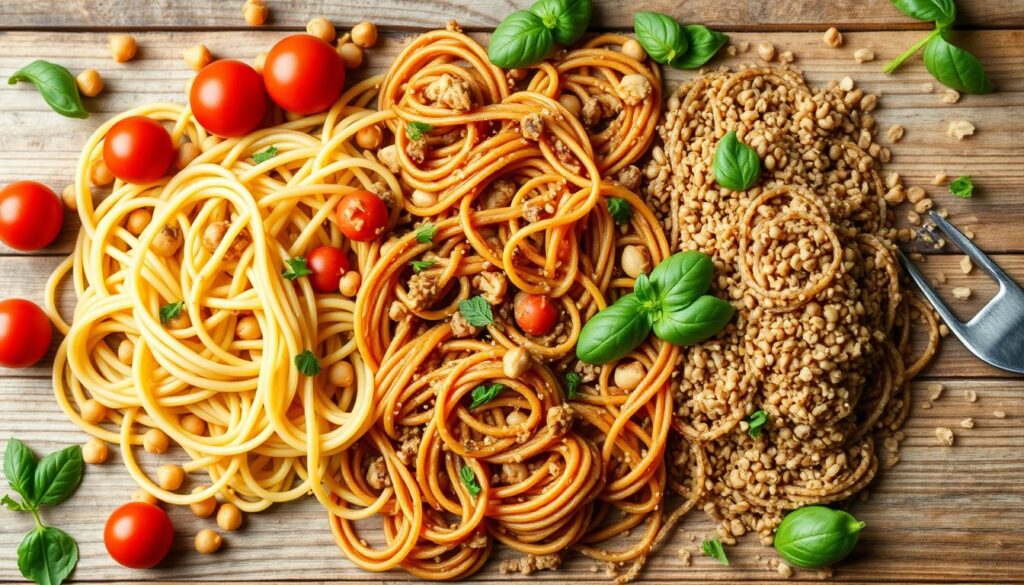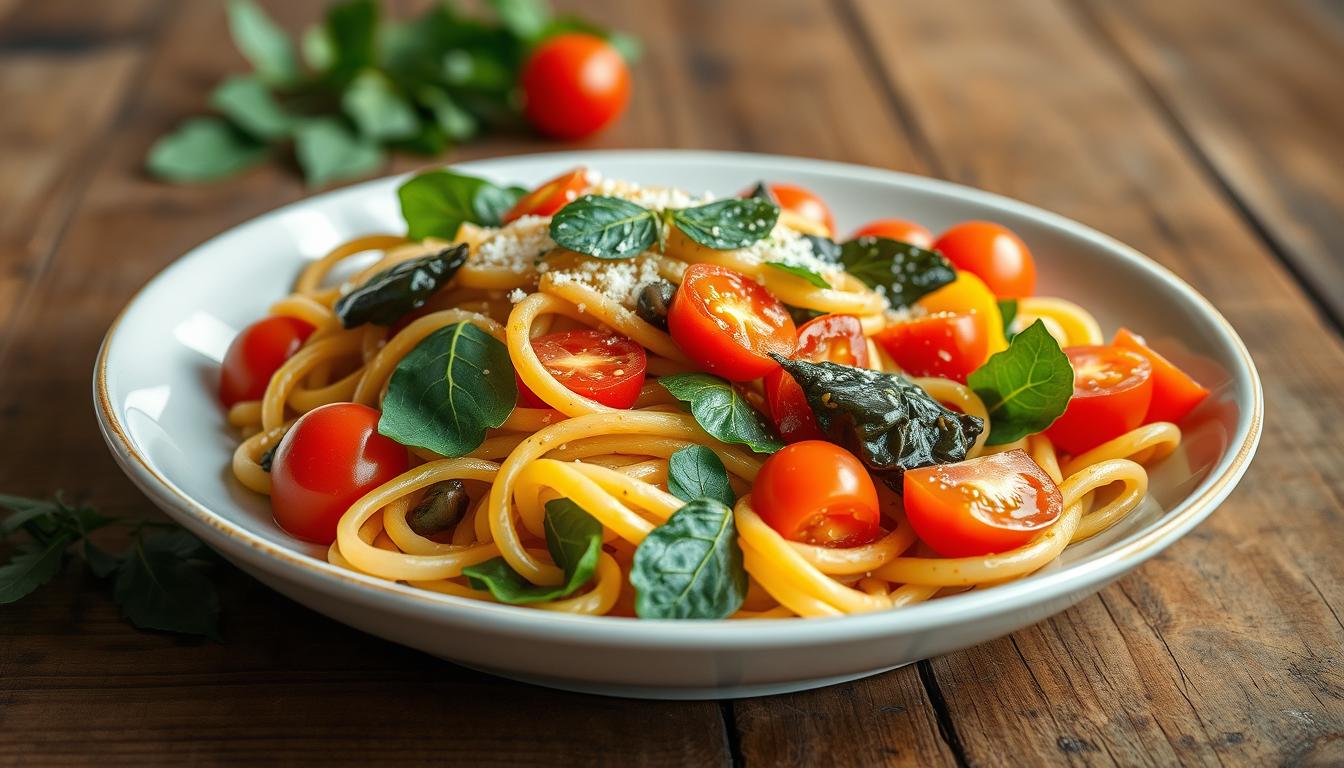Ever thought about a healthier pasta option without losing flavor or texture? Meet protein pastas, a modern twist on a classic. It’s perfect for fitness fans and health buffs looking to enjoy their pasta while getting more nutrients. Let’s dive into why protein pastas is becoming a hit in American kitchens.
Key Takeaways
- Protein pastas is a nutritious alternative to traditional pastas.
- It appeals to both fitness enthusiasts and health-conscious consumers.
- Incorporating protein-rich pastas can satisfy cravings while providing essential nutrients.
- Discover the various types and brands of protein pastas available.
- Learn how to cook and enjoy delicious protein pastas recipes.
What is Protein Pastas?
Protein pastas is a nutritious choice for those looking for a healthier pastas option. It has more protein than regular pastas. This is because it’s made with protein pastas ingredients like legumes, whole grains, and protein isolates.
Examples of protein pastas include lentil and chickpea pastas. They are high in protein and fiber. These options are great for salads or hearty meals. More people are choosing protein pastas for a balanced diet.
Benefits of Protein Pastas
Adding protein pastas to your meals can bring many health benefits. It helps grow muscles and aids in weight management. This makes it a great choice for those wanting to improve their health through eating well.
Supports Muscle Growth
Protein is key for fixing and growing muscles, especially for those who work out or play sports. Protein pastas is a handy source of quality protein. It helps muscles recover after hard workouts, leading to better performance and recovery.
Eating protein-rich foods is vital for athletes and fitness lovers. It helps build stronger muscles.
Aids in Weight Management
Protein pastas is also good for managing weight. Its protein content makes you feel full, which can lower calorie intake. This is key for those trying to lose weight or stay at a healthy weight.
Protein-rich foods keep you feeling full longer, reducing the need for snacks. Choosing protein pastas helps you enjoy your meals while working towards your weight goals.
Types of High Protein Pastas
High protein pastas is getting more popular as people look for healthier food choices. There are many types of high protein pastas, each with its own taste and health benefits. Let’s explore the most common ones.
Legume-Based Pasta
Legume-based pasta is made from lentils and chickpeas. It’s packed with fiber and plant-based protein, perfect for vegans and vegetarians. Its rich taste and texture make any dish better, plus it’s very nutritious.
Whole Wheat Pasta
Whole wheat pastas is not as high in protein as legume pastas but is still healthier than regular pastas. It keeps the good parts of the grain, like bran and germ, which are full of nutrients and fiber. Choosing whole wheat pasta helps you eat better and can help with digestion.
Protein-Enriched Traditional Pastas
This pastas has extra protein added, so it tastes like regular pastas but is healthier. It’s great for those who love traditional pastas but want more protein. There are many kinds to choose from, making it easy to fit into any diet.
| Type of Pasta | Main Ingredients | Protein Content (per 100g) | Fiber Content (per 100g) |
|---|---|---|---|
| Legume-Based Pasta | Lentils, Chickpeas | 20g | 8g |
| Whole Wheat Pasta | Whole Wheat Flour | 13g | 6g |
| Protein-Enriched Traditional Pastas | Wheat Flour, Protein Isolates | 15g | 3g |
Protein Pastas Nutrition Facts
Protein pasta has a great nutritional profile compared to regular pasta. Knowing the protein pasta nutrition facts helps you make better food choices.
Caloric Content
The calories in protein pasta depend on the brand and type. It usually has fewer calories than regular pasta because it has more protein. This can make you feel fuller longer. Here’s a look at the calories in both:
| Type of Pasta | Calories per 100g |
|---|---|
| Traditional Pasta | 130 |
| Legume-Based Protein Pastas | 120 |
| Whole Wheat Protein Pastas | 140 |
| Protein-Enriched Traditional Pastas | 110 |
Protein Composition
The protein in protein pastas is a big plus. It can have 20 to 30 grams of protein per serving. This is great for muscle recovery and overall health, especially for those who are active.
Vitamins and Minerals
Protein pastas also has important vitamins and minerals. It can include:
- Fiber, which helps with digestion
- Iron, important for blood health
- B vitamins, which help with energy
Eating protein pastas gives you not just protein but also vitamins and minerals. It helps make your meals more balanced.
Best Protein Pastas Brands
Looking for the best protein pastas brands? You’ll find many options that meet different tastes and health needs. Some brands are known for their quality, taste, and health benefits. Trying these top choices can make mealtime better and boost your protein intake.
Top-Rated Options
Many brands are praised for their excellent products. Here are some of the most loved ones:
- Banza: Made from chickpeas, Banza’s pastas is tasty and high in protein.
- Explore Cuisine: This brand offers pastas made from legumes like black beans and edamame. They’re good for protein and fiber.
- Tolerant: Tolerant is famous for its organic lentil pasta. It’s great for those who need protein and gluten-free options.
Where to Buy
Want to try these top protein pastas brands? You can find them at many places. Here are some places to buy protein pastas:
- Online Retailers: Amazon and Thrive Market have a big selection and fast delivery.
- Local Grocery Stores: Big supermarkets like Kroger and Safeway now carry brands like Banza and Tolerant.
- Health Food Stores: Specialty stores have more protein pasta brands. It’s a good place to find new ones.
How to Cook Protein Pastas
Cooking protein pasta needs careful attention to get the right texture and taste. It’s different from regular pasta because of its ingredients and cooking time. By following the right steps, you can enjoy a great meal.
To begin, measure the right amount of pasta as the package says. Usually, it’s about 2 ounces per serving. Boil water in a big pot and add a bit of salt for flavor. When the water boils, add the pasta and stir gently to stop it from sticking.
Cook the pasta for a bit less time than the package suggests. Most protein pasta takes 6 to 8 minutes to cook. Make sure it’s al dente, which means it has a nice bite. Check a piece a minute or two before the time to avoid overcooking.

When the pasta is done, drain it in a colander and save some cooking water. This water helps sauces stick better. For extra flavor, mix in olive oil or butter while the pasta is still warm.
Choosing the right sauces and toppings makes the meal better. Use light sauces like pesto or fresh tomato sauce. Add fresh veggies, lean meats, or herbs for more taste and texture.
Try different cooking methods and ingredients to make tasty and healthy meals with protein pasta.
Tasty Protein Pasta Recipes
Exploring protein pasta recipes opens the door to many tasty meals. These recipes are quick and easy to make. They suit different lifestyles and diets, making them great for everyone.
Quick and Easy Dinner Ideas
For busy weeknights, easy protein pasta dishes are a smart choice. Here are some quick ideas:
- One-Pan Pesto Protein Pasta: Mix chickpea pasta with pesto, cherry tomatoes, and spinach. Top with parmesan cheese for extra flavor.
- Lemon Garlic Shrimp and Protein Pasta: Cook shrimp with garlic and lemon, then add protein pasta. Finish with parsley for a zesty touch.
- Spicy Sausage and Bell Pepper Pasta: Cook turkey sausage, add bell peppers, and mix with whole wheat pasta. Add red pepper flakes for spice.
Healthy Lunch Options
Healthy protein pasta lunches are easy to prepare. These recipes can be made ahead, ensuring tasty and nutritious meals:
- Protein Pasta Salad: Mix whole wheat pastas with cucumbers, bell peppers, olives, feta, and a lemon vinaigrette. It’s refreshing and filling.
- Caprese Protein Pasta Bowl: Toss protein pasta with mozzarella, tomatoes, basil, and balsamic. It’s light and satisfying.
- Chicken Alfredo with Protein Pasta: Use protein pasta with a creamy Alfredo sauce. It’s a comforting and healthy choice.
| Recipe | Preparation Time | Main Ingredients |
|---|---|---|
| One-Pan Pesto Protein Pastas | 20 min | Chickpea pasta, pesto, spinach, cherry tomatoes |
| Lemon Garlic Shrimp and Protein Pastas | 25 min | Protein spaghetti, shrimp, garlic, lemon |
| Spicy Sausage and Bell Pepper Pasta | 30 min | Whole wheat pasta, turkey sausage, bell peppers |
| Protein Pastas Salad | 15 min | Whole wheat pasta, cucumbers, feta, olives |
| Caprese Protein Pastas Bowl | 20 min | Protein pastas, mozzarella, tomatoes, basil |
| Chicken Alfredo with Protein Pastas | 30 min | Protein fettuccine, chicken, low-fat Alfredo sauce |
Protein Pasta Alternatives
Looking into protein pastas alternatives reveals a wide range of choices. These options suit different diets, like gluten-free and low-carb ones.
Gluten-Free Options
Many brands now offer gluten-free protein pasta. You can find chickpea, lentil, and brown rice pasta. These are not only gluten-free but also packed with protein.
Brands like Banza and Explore Cuisine have a variety of gluten-free options. This lets pasta fans enjoy their meals without worrying about gluten.
Low-Carb Alternatives
Low-carb protein pasta is gaining fans, especially on keto or low-carb diets. Spiralized veggies and konjac noodles mimic pasta but cut down carbs.
These options let you enjoy your favorite pasta dishes while sticking to a low-carb diet. Miracle Noodle and Palmini are great for those looking for low-carb choices.

Incorporating Protein Pasta into Your Diet
Adding protein pasta to your meals can be tasty and healthy. Start by swapping regular pasta with high-protein options in your favorite dishes. This change can make classic meals like spaghetti and lasagna more nutritious without losing flavor.
Protein pasta isn’t just for traditional dishes. It fits well in salads, soups, and casseroles too. For example, using legume-based pasta in a salad can make it more filling. Adding protein pasta to creamy soups can also boost their nutritional value.
To get the most out of protein pasta, balance is key. Pair it with veggies, healthy fats, and lean proteins for a complete meal. Using protein pasta in your diet opens up new ways to cook while keeping your meals healthy. With a little creativity, it can become a key part of a balanced diet.
FAQ
What is protein pasta?
Protein pasta is a special kind of pasta with more protein than regular pasta. It’s made from things like legumes, whole grains, and protein isolates. This makes it a great choice for those who want to eat healthier.
What are the benefits of protein pasta?
Protein pasta helps build muscle, aids in weight control, and gives you important nutrients. It also makes you feel full, which is good for controlling how many calories you eat.
How should I cook protein pasta?
Cooking protein pasta needs some special care because of its ingredients and texture. Make sure not to overcook it to keep it al dente. Choosing the right sauce can also make your dish better.
What are some popular brands of protein pasta?
Top brands include Banza, Explore Cuisine, and Tolerant. Banza has chickpea pasta, Explore Cuisine has legume-based pasta, and Tolerant offers lentil pasta. They’re known for great taste and nutrition.
Are there gluten-free options for protein pasta?
Yes, there are gluten-free options. Banza, for example, has gluten-free chickpea pasta. This lets people with gluten sensitivities enjoy protein pasta’s benefits.
Can you provide a protein pasta recipe?
Here’s a simple recipe: Cook lentil pasta, then mix it with olive oil, cherry tomatoes, spinach, and feta cheese. It’s quick, nutritious, and tastes great.
What are some low-carb alternatives to protein pasta?
Good alternatives include spiralized veggies like zucchini noodles and konjac noodles. They’re low in carbs and high in fiber, making them a tasty, healthy choice.
How can I incorporate protein pasta into my meals?
You can use protein pasta in place of regular pasta in your favorite dishes. Add it to salads, soups, or casseroles. It’s a versatile ingredient that boosts meal nutrition and taste.
for more recipes visit our section dinner

